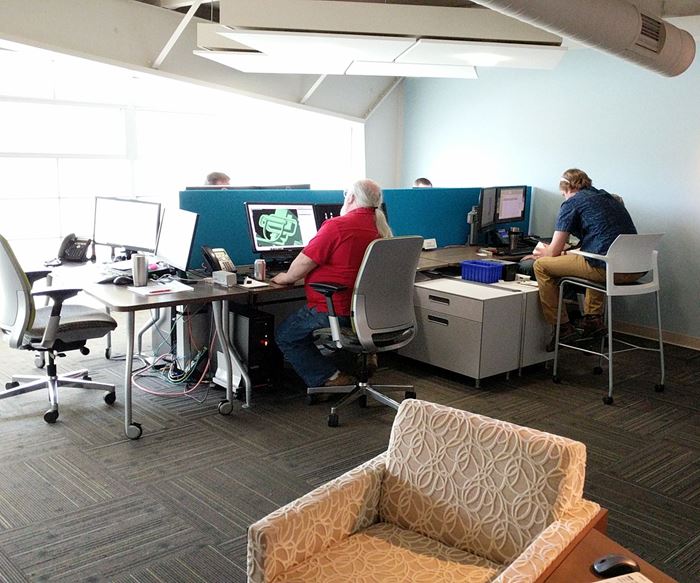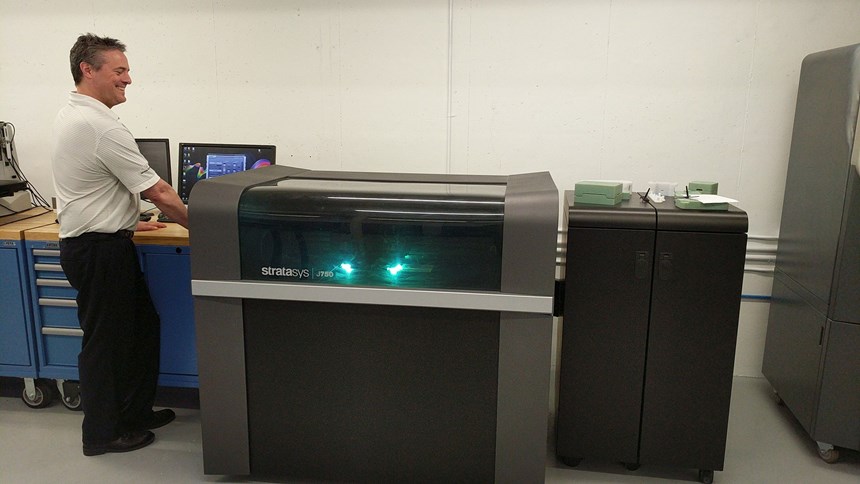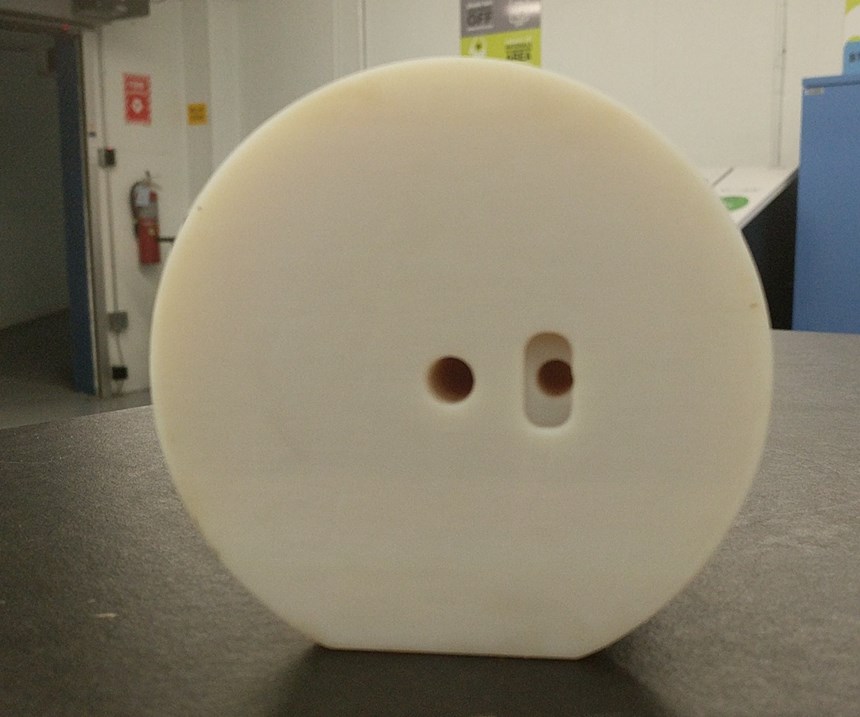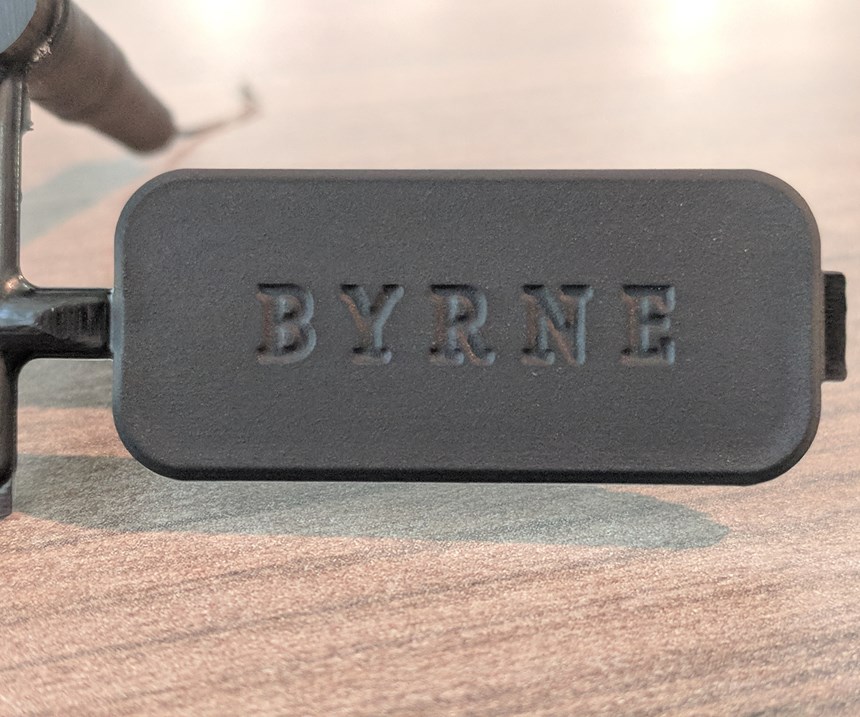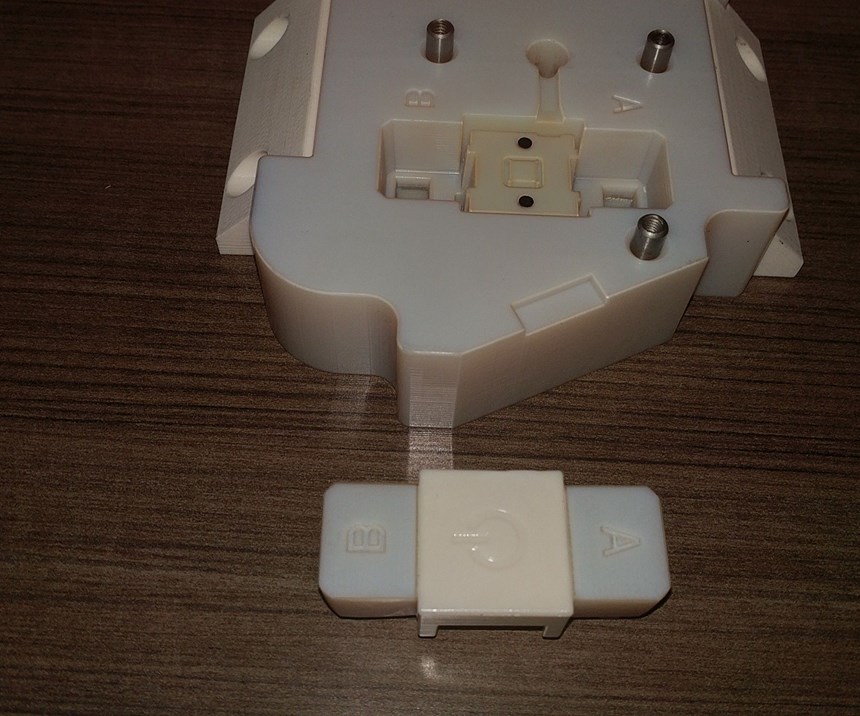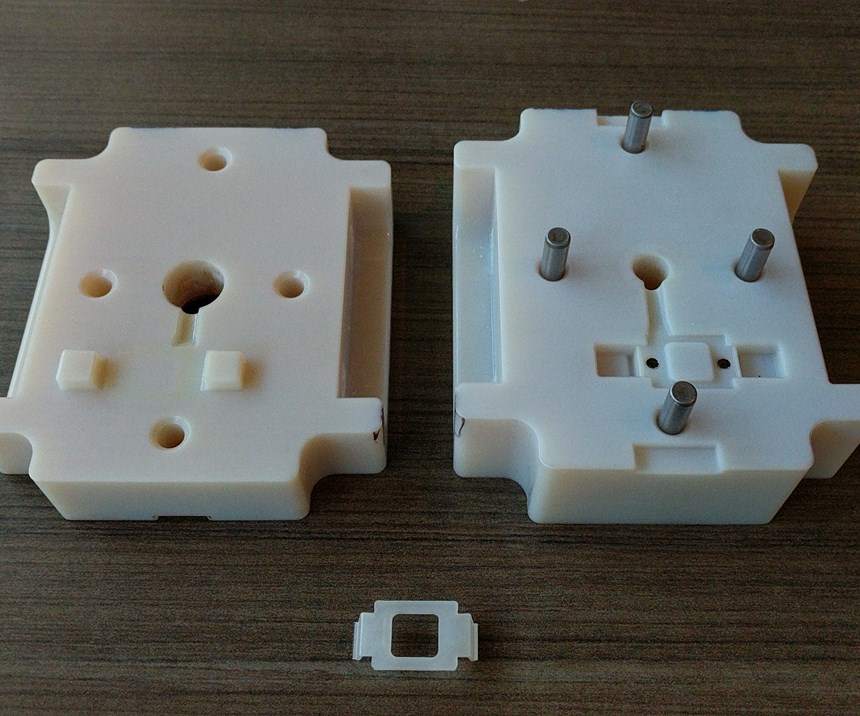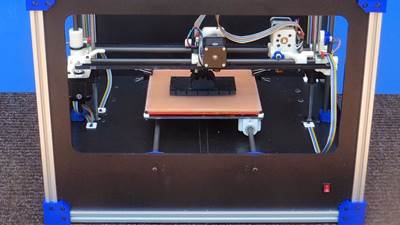3 Ways a Small Mold Builder Uses 3D Printing
How mold builder Byrne Tool + Design uses 3D printing for simultaneous mold manufacturing, conformal cooling and hybrid designs.
Share
Read Next
Like many shops Rockford, Michigan-based Byrne Tool + Design entered the world of 3D printing with an FDM machine, a Stratasys Fortus 250 MC to be exact, to produce prototype parts for its customers, to build fixtures and nests to aid the manufacturing process and to reverse engineer damaged parts and quickly print new ones.
Cost and lead time reduction for one of Byrne Tool + Design’s larger customers was the impetus for bringing more additive manufacturing (AM) technology in house, namely a Stratasys Polyjet J750 color printer to print molds that can run the actual part material. “We wanted everything in house to maintain control of the entire process,” says Marc Mitchell, Byrne Design Center manager. “No more waiting around for a quote or sending the work to outside vendors.”
This larger customer was Byrne Electrical Specialists, a manufacturer of power and data solutions for the home, healthcare, hospitality and office furniture industries, such as electrical desktop accessories and data communication center products. This relationship has proved to be a distinct advantage for the 25-person tool shop, as it delved into 3D-printed plastic molds.
Having Byrne Electrical located next door, with an experienced processing engineer on hand, has eased the additive learning process. “Alvin Smelik [at Byrne Electrical] has been known to have a fully molded part in just a couple of shots,” Mitchell says. “His experience helps to get the Byrne Tool team up to speed and producing parts in a half-hour or less.” The team now applies its in-house experience with 3D-printed molds as an offering to its entire customer base.
The shop runs its 3D-printed molds on in-house presses for its customers because the team has learned how to process these molds properly. “They are not steel molds. You can't just place a 3D-printed mold into a press and rely on previously set machine parameters for a similar part molded from a steel mold,” Mitchell says. “If you do, you’ll blow up the plastic mold.”
It seems like a long learning process, but the rewards are worth it. Within the past year, Byrne Tool + Design has increased the number of printed molds it produces and continues to encourage customers to go that route for the faster time to market, elimination of rework and early error detection to keep projects on track.
1. Simultaneous Mold Manufacturing
Byrne Electrical’s first-to-market mission requires a manufacturing team invested in new technology to help make that happen. So, using its additive technology, the team decided to take a simultaneous approach to its manufacturing.
When Byrne Tool kicks off a project for a steel tool with Byrne Electrical, it also prints a mold on the Polyjet machine at the same time. This approach enables the tool shop to design, review and print a mold within two or three days and then start shooting parts the following day. Byrne Electrical then takes these parts, builds up the assemblies and starts performing the required testing, while Byrne Tool is kicking off the steel mold design. At this point, Byrne Electrical can identify any errors in the part design, or if the part quality is good, they’ve already started the UL and regulatory testing, which helps to get the product to market faster. Then once the shop has built the steel tool, the approvals have already been completed. This simultaneous approach has reduced time to market by about three months.
For example, Byrne Tool recently produced molds with a snap clip detail that Byrne Electrical realized wasn't strong enough. “So, as we continued to design the steel mold, we changed the part design, printed a new mold, ran that mold, secured company approval on the part, and at that same time, updated the design of the steel mold. As a result, there was no delay in completing the production tool, saving the customer six to eight weeks. Basically, the cost of printing two molds was less than the cost of an engineering change to a steel mold,” Mitchell says.
2. Conformal Cooling
Another project involved Byrne Tool + Design building a new production mold for a deep, cone-shaped part utilizing conformal cooling in the core via a two-piece construction. The core for Grand Coteau, Louisiana-based Nobel Plastics had a metal outer shell that formed the inside of the molded part, and then Byrne Tool 3D printed a plastic inner core with an open conformal cooling channel that goes around its outer wall (as opposed to full-diameter conformal cooling inside of the core). The plastic printed core is placed inside the metal sleeve and sealed off, so that the water goes around and in between the printed core and the metal sleeve to cool the mold down. “The cost savings was 50 percent from a traditional manufacturing process, and it took 24 hours to print the cooling core versus almost a two-week lead time,” Mitchell says.
3. Hybrid Mold Design
Byrne Tool also uses a hybrid mold design approach that incorporates real ejector pins, steel sprue bushings and metal screws (some reusable). This helps strengthen the mold and push out the parts. The shop also puts metal sub-inserts inside printed plastic molds for more complex designs. On top of that, the shop prints hand loads to form undercuts in the part geometry.
“We also designed and built a proprietary mold splitter to evenly separate the two printed mold halves, which prevents uneven mold separation that can damage the printed mold or the molded part,” Mitchell says. Here, the shop uses metal screws in the reusable blocks that they attach to the printed mold in the mold splitter.
Byrne Electrical’s first-to-market mission requires a manufacturing team invested in new technology to help make that happen. So, using its additive technology, the team decided to take a simultaneous approach to its manufacturing.
Takeaways for Designing 3D-Printed Molds
It has taken Byrne Tool a few years to learn how to run a 3D-printed mold. Mitchell admits that they still break a few every once in a while, but they are quick to make a change and print a new one with the Polyjet machine. “It's a lot of trial and error. Originally, we built huge molds with a lot of plastic (6-inch thick, 8 by 8-inch molds) and realized it was a waste of very expensive plastic. So, we thinned the molds down.” Byrne Tool’s standard printed mold thickness is 2.23 inches thick, which is its minimum stack height for its molding press. The same concept for printing molds can be applied to aluminum molds for larger parts. To save money for larger parts, they use the same mold design but machine it out of aluminum.
Mitchell shares a few printed mold design tips the shop has learned over the past few years:
- Try to use large radiuses on parts because every sharp edge on a part design adds a lot of stress at that corner of the mold during injection, which causes mold breakage.
- When running a fire-retardant polycarbonate, which is like glue, expect about 15 parts out of a printed digital ABS mold.
- Keep the height of fine detail in the mold no larger than the base to help prevent breakage. If the mold detail requires more height than the base, then consider a steel insert to form that detail.
- Take your time. It is a learning process to get the right part design, mold design and method of processing to yield good parts.
“It seems like a long learning process, but the rewards are worth it,” Mitchell says. Within the past year, Byrne Tool + Design has increased the number of printed molds they produce (a 133 percent increase from 2017 to 2018) and continues to encourage customers to go that route for the faster time to market, elimination of rework and early error detection to keep projects on track.
Mitchell believes that Byrne Tool’s 3D-printing experience puts them a step ahead of the competition when it comes to additive technology, so as the technology advances the company can pivot and move forward. Next on the agenda: metal 3D printing of sub-inserts for finer details and conformal cooling.
Related Content
Video: For 3D Printed Aircraft Structure, Machining Aids Fatigue Strength
Machining is a valuable complement to directed energy deposition, says Big Metal Additive. Topology-optimized aircraft parts illustrate the improvement in part performance from machining as the part is being built.
Read MoreVideo: Hybrid Manufacturing Without Melting: Hermle’s Metal Powder Application (MPA) Process
The Metal Powder Application (MPA) process uses cold spray to apply metal to an existing workpiece. Because the material deforms rather than melts, MPA opens new possibilities for functional grading and other multimaterial applications.
Read MoreJuggerBot 3D Chooses Research Partners for Air Force Large-Format Hybrid Additive Manufacturing Project
Oak Ridge National Laboratory and Mississippi State University’s Advanced Composite Institute have been selected to assist in the research and technical development of production workflows using thermoplastic and thermoset deposition.
Read MoreSidus Space Successfully Launches LizzieSat Hybrid 3D-Printed Satellite
The hybrid 3D-printed satellite was manufactured using Markforged 3D printers for parts that would be incredibly lightweight, durable and custom to the structure to ensure the satellite remains intact during launch and works properly for its full life span in space.
Read MoreRead Next
The Right Design, Material and Machine Combination Takes the Risk Out of 3D Printing Molds
Full-service design and mold delivery, moldmaking materials, and a low-cost, high-precision printer minimize the technical risk of 3D-printed mold tryout.
Read MoreProfilometry-Based Indentation Plastometry (PIP) as an Alternative to Standard Tensile Testing
UK-based Plastometrex offers a benchtop testing device utilizing PIP to quickly and easily analyze the yield strength, tensile strength and uniform elongation of samples and even printed parts. The solution is particularly useful for additive manufacturing.
Read MoreAlquist 3D Looks Toward a Carbon-Sequestering Future with 3D Printed Infrastructure
The Colorado startup aims to reduce the carbon footprint of new buildings, homes and city infrastructure with robotic 3D printing and a specialized geopolymer material.
Read More

